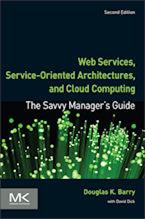WS Choreography Model
The WS Choreography Model describes the data and the relationships between them that is needed to define a choreography that describes the sequence and conditions in which the data exchanged between two or more participants.
WSDL and its extensions provide a mechanism by which the first objective is realized, however, it does not define the sequence and conditions, or choreography, in which messages are exchanged. To solve this problem, a shared common or "global" definition of the sequence and conditions in which messages are exchanged is produced that describes the observable complementary behavior of all the participants involved. Each participant can then use the definition to build and test solutions that conform to the global definition. The main advantage of a global definition approach is that it separates the process being followed by an individual business or system within a "domain of control" from the definition of the sequence in which each business or system exchanges information with others. This means that, as long as the "observable" sequence does not change, the rules and logic followed within the domain of control can change at will.
The WS Choreography Model is an information model or "meta model" for the WS Choreography Description Language (WS-CDL) that identifies the information and structures required to build a "global" definition.
Organization: W3C
More information: WS Choreography Model page on the W3C website
Context for WS Choreography Model
Related Articles for WS Choreography Model
Author
Douglas K Barry
Principal
You may use this material for your work or classes. Reprint Policy. Be sure to check the menu at the left for other articles available on this site.
The Savvy Manager's Guide
Douglas K Barry is also the author of a book that explains Web Services, service-oriented architecture, and Cloud Computing in an easy-to-understand, non-technical manner.
Web Services, Service-Oriented Architectures, and Cloud Computing: The Savvy Manager's Guide (Second Edition)
by Douglas K Barry with David Dick
This is a guide for the savvy manager who wants to capitalize on the wave of change that is occurring with Web Services, service-oriented architecture, and—more recently—Cloud Computing. The changes wrought by these technologies will require both a basic grasp of the technologies and an effective way to deal with how these changes will affect the people who build and use the systems in our organizations. This book covers both issues. Managers at all levels of all organizations must be aware of both the changes that we are now seeing and ways to deal with issues created by those changes.

